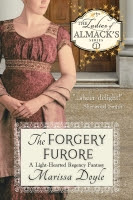 April, spring, and Easter all combined to make this month particularly enjoyable for young lads and lasses in nineteenth century London. After all, Easter marked the traditional start of the Season, when anyone who was anyone came to London to take part in Society and its rituals. But it wasn’t just the wealthy that celebrated this time of year. If you were one of the poorer people, for example, you might find it necessary to hang out at Whitehall Chapel on Maunday Thursday, the day before Good Friday. That’s the day His Majesty’s almoner distributes gifts to the poor.
April, spring, and Easter all combined to make this month particularly enjoyable for young lads and lasses in nineteenth century London. After all, Easter marked the traditional start of the Season, when anyone who was anyone came to London to take part in Society and its rituals. But it wasn’t just the wealthy that celebrated this time of year. If you were one of the poorer people, for example, you might find it necessary to hang out at Whitehall Chapel on Maunday Thursday, the day before Good Friday. That’s the day His Majesty’s almoner distributes gifts to the poor. (Now there’s an interesting profession: the Royal Almoner. Appointed by the monarch, the position comes with the title of Lord High Almoner, letters patent, a tidy salary, and the ability to appoint a sub-almoner to help out. He conducted one lecture a year on Maunday Thursday when he made the major distribution of gifts to the poor. But he also distributed gifts to pay for funerals, to compensate for crimes, and to simply hand out kindness from His or Her Majesty.)

The days after Easter are similarly festive. Easter Monday, Sadler’s Wells, Astley’s Ampitheatre, and the Royal Circus open. That same day, the Lord Mayor and Aldermen go in state to Christ-Church, attend service, and then go to feast at the Mansion House. Be sure to attend the ball that evening; tickets are to be had from the Lord Mayor or the sheriffs.
Ah, but if you really wanted a spectacle, Easter Monday and Tuesday you would head out to Greenwich for the Fair. Charles Dickens commented fondly on the practice in his Sketches by Boz, calling Greenwich Easter Fair a "spring rash" and a "three days’ fever." Carriages, wagons, and omnibuses carried merry Londoners out to the event. Stalls of vendors selling things like sweet meats, gingerbread, and toys filled the streets, and there were wild animal shows and theatricals.

Even more boisterous events brought throngs to the park. There were games for the children and young at heart. Retired Naval men set up telescopes and charged a penny for the privilege of explaining what you saw through them. Gypsy fortune tellers worked the crowds. Some adults were content to stroll about and watch the revelry. Others danced and drank and flirted. And some tumbled.
Tumbling seems to have been both a shocking and much beloved event. The idea was to take your sweetie by the hand and climb to the top of Observatory Hill. There you’d link arms with a dozen or more men and women and dash down the slope together. Only some kept their footing. Others fell or rolled to the bottom. Bonnets were squashed; curls were disarrayed; and I imagine more than one gentleman caught a glimpse of shapely ankles and other portions of a lady’s anatomy.
The public frolic and revelry was so great that in 1857 the fair was outlawed as dangerous to order and public morals. And here I thought all those chocolate bunnies were the most dangerous thing about the Easter season!
(Greenwich Fair image from the Bolles Collection at the Digital Collections and Archives, Tufts University)





No comments:
Post a Comment